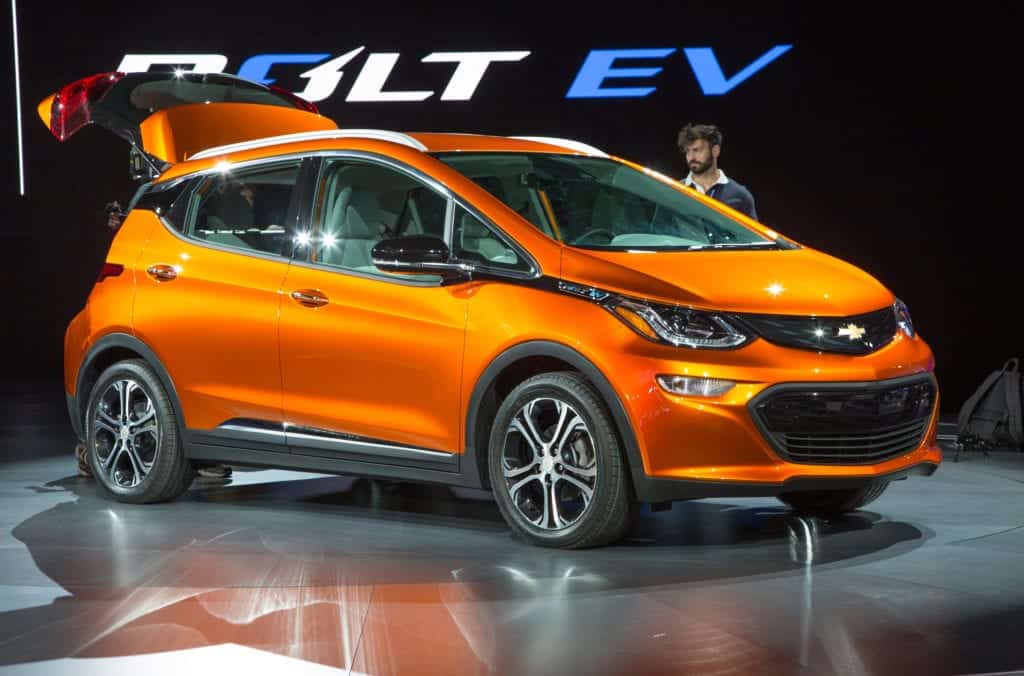A Bolt from the bowtie

Nothing’s new about electric cars. The first vehicle to top 60 mph — in 1899 when some thought such speeds might lead to organ failure — was electric.
Jay Leno notes that in 1905 one third of the cars sold in the U.S. were electric, one-third gas and one-third powered by steam. Only gasoline survived.
Times are different now. There are currently 11 electric cars sold in the U.S. — from Nissan, Ford, BMW, Mercedes-Benz, Smart, Chevrolet, Fiat, Kia and Mitsubishi with a pair from Tesla.
Weighing whether to go electric means balancing such issues as costs, charging time and convenience. And driving range. Other than the expensive Teslas ($66,000 and up) and their Supercharger grid, the range of electrics is between 62 and 107 miles, most around 85 miles.
Into this mix, badged with Chevrolet’s bowtie emblem, hums the all-electric Bolt. That’s Bolt with a B and not Volt with a V, the latter being Chevy’s plug-in hybrid, whose sales have been disappointing.
New for 2017, the Bolt is a cute little 4-door sedan with an exterior design that sets it off from other small EVs without looking odd, like BMW’s i3 and Nissan’s Leaf. Dimensionally the Bolt is slightly taller and shorter front-to-rear than a VW e-Golf. So what sets the Bolt apart from other small EVs?
Just one number: 238.
That’s the mileage range per charge of the little Chevy. It’s not much less than Tesla models costing nearly twice as much and therefore it changes the ballgame — taking the Bolt out of the urban car (i.e. glorified golf cart) category with range to roam. This coup for Chevy comes on top of another one: In the J.D. Power 2016 Initial Quality Study, Chevrolet finished 6th out of 32 marques, one place behind BMW and ahead of Lexus and Mercedes-Benz.
It’s thought Tesla’s Model 3, smaller and less expensive than the Model S, will also have a range of 200-plus miles, but it is still at least a year away.
Chevrolet versus Tesla? Tesla’s website states that Model 3 “production begins mid 2017. Delivery estimate for new reservations is mid-2018 or later.” You can buy the Bolt late this year. So it’s a question of purchasing practicality now or waiting for cachet later.
Bolt’s front-drive power comes from a motor with 200 horsepower and 266 lb-ft of torque. With the electric motor’s torque from zero rpm, Chevrolet suggests a 0-60 time of 6.5 seconds and a top speed of 91 mph. Urge for the motor comes from a 960-lb, 60-kWh battery system with 288 lithium ion cells in five packs. They are fitted under the floor with the last two stacked beneath the back seat. The warranty is 8 years or 100,000 miles.
As with most EVs, the Bolt proves to be smooth, quiet and rather quick, being particularly impressive in transition acceleration, like 30-50 mph. That’s nice for passing cars and trucks. It can also be fun to stop, using the steering wheel-mounted Regen on Demand paddle to bring the Bolt to a halt without using the brakes — and picking up a bit of energy in the process.
Being a hatchback design, the Bolt’s interior is utilitarian with 60/40 folding second seatbacks. There’s room for four average-size adults. Five in a pinch.
Facing the driver is a digital dash with such info as speed, range, regen (i.e. regeneration is underway) and radio station. To the right is a 10.2-inch iPad-like screen with oodles of information, including the battery-charge level and the amount of power being consumed by that energy sewer known as the heating/air-conditioning system.
The list of menu details is as long as, well, an extension cord. One is “Charge Cord Theft Alert.” Another is called “Hill Top Reserve.” If you happen to live on a hilltop, the system can limit plug-in charging to 90 percent so you can take advantage of regeneration as you brake going downhill.
The basic Bolt is the LT model at $37,495 including destination charge, while the upgrade Premier version is $41,780. Then subtract the $7,500 you’ll get back from the feds, with local incentives that range from additional money to the use of carpool lanes. Naturally all the expected options are available from forward collision alert to a Wi-Fi hotspot.
For those who suffer from range anxiety and don’t care to pay the Tesla tab, the Chevy EV is a good solution. It’s cute, comfortable and affordable. And sensible. I could see one in my garage.
But how many other garages? LG Chem, the South Korean firm that makes the batteries and other elements of the Bolt, predicts Chevrolet will sell 30,000 Bolts in 2017. Chevrolet Volt sales will likely come in around 23,000 for 2016.
Those are two small drops in a 16 million-plus cars-per-year bucket, the current size of the U.S. market. In a world of cheap gas and ever-better gasoline engines, electric cars will remain a tough sell regardless of federal fuel mileage standards.
As for that electric car that set the speed record in 1899, it still exists in a museum in Compiègne, France. Belgian Camille Jenatzy drove the torpedo-shaped vehicle, which was named La Jamais Contente. That translates as “The Never Content,” said to be named for his wife.
Jenatzy claimed he would never die in an automobile and he didn’t. He did, however, once dress up in a bearskin to scare his hunting guests and one of them shot him.
Shocking.

